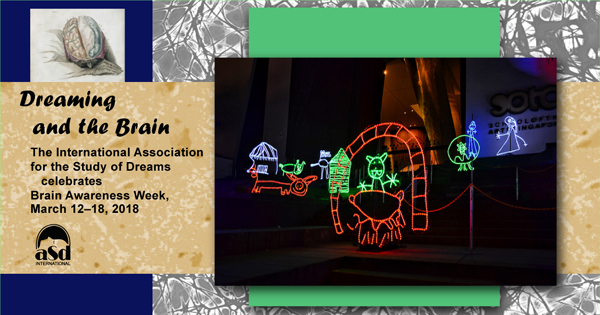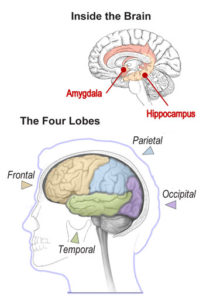
Children’s Dreams and the Maturing Brain
By Joseph De Koninck, PhD
 Sigmund Freud noted that his daughter Anna had her first known dream at the age of 19 months, when she called out in her sleep about strawberries and scrambled eggs. But our conjectures about the earliest dreams in children – or even, possibly, in fetuses – are extrapolations from our knowledge about dreams at other ages.
Sigmund Freud noted that his daughter Anna had her first known dream at the age of 19 months, when she called out in her sleep about strawberries and scrambled eggs. But our conjectures about the earliest dreams in children – or even, possibly, in fetuses – are extrapolations from our knowledge about dreams at other ages.
We know that dreams can occur throughout a night of sleep, and even in short naps. However, the most vivid dreams occur in rapid eye movement (REM) sleep, which occurs in the young adult every 90 minutes and occupies 25% of sleeping time.
In the newborn, REM sleep occupies 50% of sleep time, which can be up to 18 hours a day. Howard Roffwarg, an early pioneer in sleep and dream research, proposed with others in 1966 that this predominance was essentially a mechanism of internal auto stimulation fostering the development of the brain and nervous system during the period when external stimulation is limited. In 2009, psychiatrist J. Allan Hobson applied similar reasoning to fetuses in his “protoconsciousness” theory; there is no current way to test that theory.
Because children cannot express themselves elaborately, especially verbally, during the first years of development, dream researchers are seriously handicapped in their study of very young children’s dreaming experience. Here is what has been learned from studies of children aged 3 years and older.
Early dream development
David Foulkes is recognized for having pushed the study of early-life dreaming to the limit. In 1982 he reported a longitudinal study of the dreams of healthy children aged 3 to 15 years, in which he woke the children during REM sleep and asked them to recall their dreams. He came to the conclusion that elaborate dreaming cannot occur before the age of 3, because the child has not yet attained the prerequisite brain and cognitive maturity. Indeed, at the age of 3, children’s reports of dreams contained fewer than 15 words, and lacked a story-like structure. It is only by 5 to 7 years old that children reported dream experiences with characters, themes, and actions. Further studies, of home dreams at ages 9–11, 11–13, and 13–15, showed a gradual appearance of an active self, interactions, aggression, and the dreamer as a victim.
Why dreams tend to be negative
A most intriguing observation emerged when dreams were obtained in both home and preschool settings: children reported more unpleasant than pleasant dreams. Indeed, they reported being chased, bitten, and devoured. Often, scary animals are represented alongside parents and familiar characters. It is also well-documented that nightmares are frequent between the ages of 6 and 10 years. This phenomenon is now considered normal, and the nightmares tend to disappear with early adolescence.
Interestingly, modern brain research has brought some answers about this tendency for dreams – throughout most of life – to be unpleasant and to contain more negative emotions than in waking life. Imaging and internal brain connectivity studies suggest that brain centers normally connected and interacting during waking become more independent during sleep, particularly in REM sleep.
 A small region on each side of the brain called the amygdala, which is largely responsible for emotions – particularly fear – is spontaneously activated in REM sleep. At the same time, the frontal region of the brain, which tempers emotional expressions in waking, is apparently more subdued, or at least less connected. This may explain the emergence in dreaming of more intense negative experiences and even, in special cases, nightmares. The normal disappearance of nightmares by ages 11 to 12 years would be associated with maturation of brain functioning – the frontal-lobe connections become more efficient at controlling emotions – and also explained in part by children’s emotional learning, such as how to cope with fears.
A small region on each side of the brain called the amygdala, which is largely responsible for emotions – particularly fear – is spontaneously activated in REM sleep. At the same time, the frontal region of the brain, which tempers emotional expressions in waking, is apparently more subdued, or at least less connected. This may explain the emergence in dreaming of more intense negative experiences and even, in special cases, nightmares. The normal disappearance of nightmares by ages 11 to 12 years would be associated with maturation of brain functioning – the frontal-lobe connections become more efficient at controlling emotions – and also explained in part by children’s emotional learning, such as how to cope with fears.
Similarly, the hippocampus – another region in each brain hemisphere, and heavily involved in memory – is also differently connected with other centers during sleep. This explains why dreams can contain such a wide range of souvenirs from waking life – both recent and long past – although in many ways they’re distorted.
These alterations in brain functioning during sleep explain in part why dreaming generates virtual experiences that can be most interesting in terms of self-knowledge and creativity.
Dream construction and manipulation
Modern research has also taught us how to have partial control of dreams, to temper their negativity when necessary (such as in nightmares), or simply to enhance dream experience.
For example, Mélanie St-Onge’s 2003 doctoral thesis at the University of Ottawa demonstrated that children aged 11 to 12 years who still experience nightmares can learn to control them using imagery rehearsal therapy (IRT). Children were asked to write down their nightmares and then write a new, pleasant version. Then they rehearsed the new version before going to bed. Within a week, most nightmares in the group had disappeared. Valerie Simard at the University of Montreal successfully used IRT, as well, but asked the children instead to draw a picture of their nightmares and alter their images.
In addition to being able to influence dreams with presleep suggestion, control within lucid dreams is a possibility. A lucid dream is one within which the sleeper is aware of dreaming, and many children have lucid dreams. It is well known now that the ability to take control of an ongoing lucid dream experience to change its course in a desired direction can be learned. This promising dream manipulation technique can be used by children to notably reduce their nightmares. Given children’s capacity to quickly learn complex skills such as languages, this may be a valuable approach to enhance their dream experience and possibly their psychological adaptation at an early developmental stage.
Indeed, Ursula Voss and collaborators have recently studied lucid dreams in students aged 6 to 19 years and observed how young children can spontaneously discover the capacity to change the course of dreams. They recommend the further exploration of dream lucidity for use in therapy beyond the alleviation of nightmares, to the reduction of waking anxiety and impulsiveness. Caution is needed, though: it has been demonstrated that during lucid dreaming, the brain is not totally in typical sleep mode, and the impact of lucid dreaming’s prolonged use on the recuperative value of sleep has not been evaluated.
Exciting progress has been made in our understanding of the phenomenon of dreaming in children. While there is no doubt that brain maturation shapes dream formation in the child, it is also clear that, even in the child, waking mentation can alter dream experience and contribute, in turn, to adjusting the brain’s own patterns of dream formation for the benefit of the child’s well-being.
…………………………………………………………………………………………………………………………..
© 2018 Joseph De Koninck. Joseph De Koninck is emeritus professor in the School of Psychology, the Brain and Mind Research Institute, and the Institute of Mental Health Research of the University of Ottawa. He is a fellow of the Royal Society of Canada and was honorary president of the Canadian Psychological Association. A past president of the Canadian Sleep Society, he is a recipient of its Distinguished Scientist Award.
Banner images: (Center) Flickr/“Children’s Dreams #3,” Choo Yut Shing, CC BY-NC-SA. (Left) Plate 1. Sir Charles Bell, The anatomy of the brain, 1802. Wellcome Collection, CC BY.
The International Association for the Study of Dreams is a nonprofit, international, multidisciplinary organization dedicated to the pure and applied investigation of dreams and dreaming. Our members variously explore dreams through the sciences, the humanities, the arts, clinical applications, and their own experiences. See our website (ASDreams.org) for information on dream research, research grants, membership, and conferences. IASD is a partner in the global Brain Awareness Week campaign of the Dana Alliance, which offers a large selection of brain education materials on its website (dana.org/baw).
